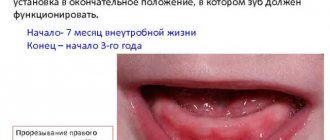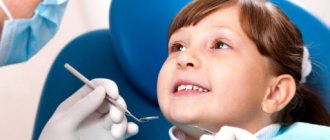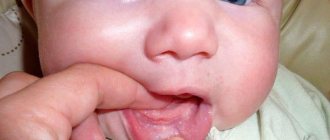The appearance of an infant’s first milk teeth is a difficult period for both him and his parents. The baby often cries, is capricious and demands increased attention from mom and dad. Teething is often accompanied by an increase in temperature. It lasts for 1-3 days, after which the child’s condition stabilizes.
Teething can be called a purely individual process. In some children it is completely asymptomatic, while in others very unpleasant symptoms appear that significantly worsen the baby’s life - diarrhea, hyperthermia, loss of appetite, inflammation of the gums and others. This clinical picture often confuses parents - they cannot understand whether these signs are related to teething or whether the child is developing some kind of pathology.
Parents' biggest concern during teething is temperature. It can rise to dangerous levels - 39-40°C. To alleviate the child’s condition, it is necessary to be able to provide him with first aid, as well as to recognize in time the signs indicating that you urgently need to either call an ambulance or go to the hospital yourself.
Why does the temperature rise
Teething is a traumatic process. Dental units damage the gum mucosa and inflammation occurs, which in medicine is called aseptic (microbial-free). This process is accompanied by an increase in temperature. In addition, during teething, some processes occur in the baby’s body that stimulate hyperthermia:
- at the site of localization of future milk teeth, specific substances necessary for softening the bone tissue of the jaw begin to be actively produced;
- Since all the forces of the child’s body are aimed at teething as quickly as possible, the immune system weakens a little. During this period, infectious agents present in the body may become active and diseases will begin to progress. Many of them are accompanied by an increase in temperature.
Damaged gums are the “entry gate” for infection. Through them, pathogenic microflora can penetrate the body and provoke the development of a septic inflammatory process. The body also responds to such an attack with an increase in temperature. To prevent infection, it is recommended to take more careful care of your baby’s gums during this difficult period for him. Pharmaceutical companies now produce many drugs that have a triple effect - relieve pain, reduce inflammation, fight viruses, bacteria and fungi. But before using these medications, it is recommended to consult your pediatrician.
Reasons for falling out earlier than expected
Teeth begin to fall out prematurely. This situation occurs when the child was injured or the tooth was sick and was removed prematurely . Since this has happened, there is no need to be upset. Modern dentistry has recently moved forward and doctors have invented “artificial space retainers.” What function do these retainers perform? Simple. Using an ordinary plate attached to a tooth, the place where the permanent one should appear is held.
In general, the process of losing baby teeth and replacing them with permanent ones is quite demanding of your attention. After all, healthy teeth are the key to your child’s future self-confidence and beauty. So parents take great care of their children during this period, so that the whole process goes without unnecessary nuances.
Particular attention should be paid to:
- Oral hygiene.
- Baby food diet to include all the essential vitamins and minerals that a child’s body needs.
- More often than not, the child tries to pull out the loose tooth himself and touch the wound. In this case, it is necessary to explain to the child that the tooth should fall out on its own and it is not necessary to touch it, so that microbes do not penetrate into the wound and the inflammatory process does not begin. A visit to the pediatric dentist at least once every six months is also necessary to consult on any questions that may arise.
Teething symptoms
A child's first teeth begin to erupt between 4 and 8 months. There are exceptions. Sometimes children are born with several teeth, while others show them only after a year. Teething is a difficult process for a child. It can be accompanied by various symptoms, but the most common are the following:
- How long does it take for drugs to leave the body?
- Increased nervousness. The child cries for no reason, whines. Teething may be accompanied by painful sensations that prevent him from sleeping normally. As a result, the regime of wakefulness and rest is disrupted.
- Heavy salivation. This is a protective process. Saliva has anti-inflammatory and bactericidal properties. Hypersalivation helps protect inflamed gums from infection. Sometimes there is so much saliva that it flows down the chin onto the neck and chest. You should not constantly rub your baby's delicate skin. It is permissible to periodically carefully blot with dry wipes.
- Loose stools. During teething, the baby may experience diarrhea. It is caused by increased salivation, changes in intestinal microflora, or increased bacterial activity due to a decrease in the body's immune defense.
- Decreased appetite. Often, due to pain in the gums, infants refuse to eat. In this case, it is a little easier for those who are breastfed, since the sucking process calms and pacifies the baby.
- Inflammation of the gums. This is the natural state of affairs at the time of teething. If a white stripe appears in some place of the gum, the tooth will soon come out.
- Runny nose. Sometimes swelling and inflammation from the gums spreads to the nasal mucosa. As a result, the baby begins to snot.
- Itching in the gums. The baby puts all the objects that come to hand into his mouth. This is how he scratches his gums. To make his task easier, you can purchase special teething toys in stores.
- Hyperthermia. The temperature rises in 80% of cases. It is important to ensure that it does not reach critical levels. Once every 1-2 hours, it is recommended to measure it not with an electronic, but with a mercury thermometer, since it is more reliable.
All these symptoms frighten parents, as they are similar to the signs of many other diseases of the upper respiratory tract and gastrointestinal tract. These symptoms are typical for teething. But you need to monitor the baby’s condition very carefully, and if the clinic is accompanied by other alarming symptoms, you need to immediately contact your doctor.
When do children's baby teeth fall out?
It is believed that, on average, baby teeth begin to change to permanent teeth at the age of six. But, as a rule, when baby teeth erupt, at that age they begin to change. If the first teeth appear at 5 months, then permanent teeth will begin to appear at 5 years; if at 6 months, then at 6 years. They fall out the same way they grew: first the lower incisors become loose, then the upper ones. But if it’s the other way around, it’s okay. At 6-8 years old, the lateral and central incisors change, at 9-11 years old - the lower canines, at 10-12 years old small molars and upper canines appear, and by 13 years after the appearance of the second molars, the formation of a permanent dentition ends.
What you need to pay attention to: When a baby tooth falls out, the socket may bleed. It should be wiped with a sterile swab. And do not allow the baby to eat or drink for two hours. On this day, avoid spicy, sweet or bitter foods altogether.
And one more thing: you need to feed your teeth properly. That is: during the period of their growth, the child should eat foods with calcium: cheese, cottage cheese, milk, kefir. Lots of fruits and vegetables, and he should gnaw some of them: so that the roots of the baby teeth are better absorbed and the molars are strengthened.
Be sure to eat fish twice a week. It contains phosphorus. And it’s better to completely exclude sweets, especially sticky toffees, sweet soda and baked goods.
Symptoms indicating pathology
An increase in temperature during teething is a natural process. This is a kind of protective reaction of the baby’s body. At this time, it is necessary to carefully assess the general condition of the child. Sometimes dangerous pathologies can be hidden behind teething syndrome. Therefore, parents should know the symptoms indicating the progression of the pathological process:
- Vomit. Single vomiting can occur at high temperatures. But if it recurs, the baby feels very bad and has diarrhea, you need to see a doctor as soon as possible. These are signs of intestinal infection or poisoning.
- Nasal congestion or discharge of thick yellow-green snot. This is not the norm, it is a pathology that requires adequate and immediate treatment.
- Coughing. During teething, a lot of saliva is released. Often children simply do not have time to swallow it, and they may choke. A cough appears reflexively, which is not pathological. But if wheezing is heard and a certain amount of sputum is released during coughing, this indicates the development of diseases of the upper respiratory tract (tracheitis, bronchitis and others).
- Stomach ache. With normal teething, this symptom should be absent. If the baby is restless, capricious, cries, or pulls his legs toward his stomach, these are alarming signs. Especially if the abdominal pain is accompanied by repeated vomiting. This symptom complex indicates the development of an intestinal infection. The child could pick it up through toys and other objects that he pulled into his mouth.
- Red throat. Swelling from the gums does not spread to the palate. It can spread to the nasal cavity. If the throat and palate are hyperemic (reddened) upon examination, this is the first sign of the development of pharyngitis.
If you have at least one of these symptoms, you should immediately contact your doctor or go to a medical facility. There the child will be examined by a pediatrician and prescribed the correct treatment. It is prohibited to give any medications (except antipyretics) at home without prior approval from the doctor.
How long does the temperature last
During teething, the temperature rises on average to 37.7°C. This has practically no effect on the general condition of the child. He is active, eats well, plays. But hyperthermia can also reach high numbers - 39-40°C. In this case, the baby is lethargic, capricious, and refuses to eat. It is better to take measurements every 1-2 hours. If the increase is critical, an antipyretic drug should be given. Normally, the temperature during teething can last up to three days. If hyperthermia is present even on the 4th day, you cannot do without the help of a doctor.
When to lower the temperature
There is no need to lower the temperature to 38.5°C. If it rises higher, you need to take action. Hyperthermia affects many processes in the human body. During fever, the water-salt balance is disrupted and the load on the heart increases. In severe cases, convulsions may occur that can lead to respiratory arrest. In no case should this be allowed to happen, as this would pose a threat not only to the health, but also to the life of the little patient.
- How many days does a baby's teething temperature last?
When to give antipyretic drugs:
- temperature exceeded 39°C;
- breathing rate increases;
- the baby sleeps for a very long time;
- the child is restless, cries, cannot calm down;
- drying of mucous membranes, redness of the skin;
- the occurrence of convulsions (in this case, they give an antipyretic and immediately call an ambulance).
If the child has already had convulsions once, the temperature must be brought down when it exceeds 38°C.
What can you do to bring down the temperature?
An increase in a child's temperature is always a reason for panic among his parents. But it is important to control yourself and be able to properly help your child. To normalize body temperature, you can resort to methods of traditional and folk medicine.
Medications
For young children, it is best to give the medicine in syrup form or use rectal suppositories. Both the baby and the older child will refuse to take the bitter pill, and giving it to him will be problematic. If you don’t have anything else at hand, then you can try mixing the medicine with something tasty - honey, fruit puree.
Medicines for fever in a child
To normalize a child's body temperature, medications based on paracetamol or ibuprofen are used in pediatrics. The first can be given to a baby from the first days of life, the second - from three months. Before use, you should consult with your doctor, and also study the instructions for the drug in detail, paying special attention to side effects and dosage.
Traditional methods
If you don’t have the required medications in your medicine cabinet at the right time, you can resort to traditional methods of lowering your temperature. They allow you to reduce the heat by 1-2 degrees. This is often enough to stabilize the child’s general condition.
Effective methods:
- Toothache and fever
- Physical cooling with a diaper or sheet. This method can hardly be called purely folk, since it is also used in medical institutions. Its essence is to cool the “burning” human body. It is necessary to wet the diaper in warm water and wrap it around the baby.
- Rubbing with warm water. It is necessary to prepare a sponge and a deep container with water. Her temperature should be 36-37 degrees. Water that is too cold can cause chills and even trigger cramps. Hot water will not bring the expected effect. Take a little warm water into a container, moisten a sponge in it and carefully wipe the child’s feet and hands, elbows and knees, and armpits.
- Cabbage leaves. They need to be kept in boiling water, and then beaten a little, cooled and applied to the baby’s body.
- Linden blossom. It can be given even to children under one year old. It has a pronounced diaphoretic effect. As a result, the child sweats and body temperature decreases. Use after consultation with a specialist and in the absence of an allergic reaction to this plant.
It is best to use traditional methods of treatment in tandem with traditional ones. This will not only achieve the desired effect, but also quickly improve the child’s condition.
Is there a fever when changing baby teeth to permanent ones?
Six years is the age when children replace their baby teeth with permanent ones.
The front incisors are the first to change. The first permanent molars or, as they are popularly called, “sixes” can also be seen at this age. A change in bite can be divided into several stages. The first stage is the formation of an early mixed bite; it consists of the first “sixes” and incisors located in the center. The second stage is a period of rest, during which molars do not appear. By the age of 9-11, the child’s teeth change in the supporting zone: permanent premolars replace the molars. By the age of 12-13 years, the permanent bite is fully formed. This is the order in which children change teeth. Crying, screaming, whims
Many parents remember with horror how their children’s teeth changed: fever, hysterics, and the sick, unhappy appearance of their beloved child drives them crazy. Of course, you need to understand that the appearance of both baby and permanent teeth is an unpleasant situation. But you are able to help the baby and ease his suffering. As for the appearance of the first teeth, this is a painful process, and it is rare that any child does not react to it with a fever. You need to fight it as soon as it exceeds 38°. During this period, use cooling teethers, dental anesthetic gels (Kalgel, Kamistad, Cholisal), and give your baby a light massage of the gums with a fingertip or a special massager. Changing a child's teeth to permanent ones can also be accompanied by lethargy and low fever, but tooth loss occurs painlessly in most cases. However, if the appearance of a permanent bite is delayed, gum inflammation may occur, which requires consultation with a pediatric dentist. Sometimes the doctor may decide to pull out a baby tooth if it is time to stimulate the appearance of a permanent one.
Parents' mistakes
The most common mistake parents make is worrying about the fact that the permanent teeth have become uneven after erupting. At 6-7 years old, when the child’s teeth change, affecting the front, central and lateral incisors, a large gap appears between these teeth, and you can also see that they are tilted to the side. Worries about this are in vain. This is a physiological norm, that is, they should be at an angle because in the future the anomaly will self-regulate. At this age, any external intervention is undesirable, since the alignment of erupted teeth can negatively affect other teeth that will emerge later. To be sure that your child’s transition to permanent teeth is normal, take your child to a pediatric orthodontist.
What not to do when teething
It’s hard to look at a child when you know that he’s feeling bad right now. Therefore, many parents try to take some measures to somehow help their child. But not everything goes to his advantage. During the teething period, you cannot rush the course of events. Teeth will erupt in any case. If you try to speed up this process, you can only do harm.
What not to do:
- give adult medications to bring down the temperature;
- wipe the child with vinegar or alcohol;
- massage the gums;
- make cuts on the gum so that the tooth emerges faster;
- give the child dry bread crust (it can scratch the swollen tissues in the mouth and infection can penetrate through the wounds).
Now in children's stores there are a sufficient number of various “rodent” toys, as well as pain-relieving gels that will help simplify the teething process and reduce pain and inflammation. It is to them that you need to resort if there is a need to help the baby.
“Rodents” for teething children
Signs of changing baby teeth
Before the molars appear, a very interesting physiological process begins - the independent resorption of milk. At this time, the milk units become mobile and fall out. The rudiments of permanent teeth appear in the area of the roots of primary dental units. In this place, where the root is adjacent to the permanent tooth germ, the resorption process begins, which leads to the loss of the baby tooth.
The final release of the oral cavity from baby teeth occurs around the age of fourteen. This process occurs individually for everyone, so for some it ends earlier, for others later.
The process of loss of the milk and the appearance of the radical occurs simultaneously. Most often, the appearance of teeth and their loss occurs according to the following scheme:
- first the incisors;
- first molars;
- fangs.
The first molars appear a little later, despite the fact that they begin to grow long before the milk teeth fall out. Second molars appear only when the jaw grows and there is room for them. Third molars, called wisdom teeth, can appear at any age or may not grow at all.











